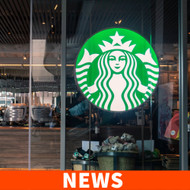Starbucks’ “Back to Starbucks” plan delivers first growth in two years
Posted by Emma on 30th Oct 2025 Reading Time:
Starbucks has recorded its first sales increase in almost two years, a sign that CEO Brian Niccol’s ambitious turnaround plan is beginning to bear fruit. The coffee giant reported a 1% rise in global same-store sales between July and September — its first gain in seven quarters — marking a tentative return to growth after a prolonged slump .
A Return to the “Third Place”
When Niccol joined Starbucks last year from Chipotle, he inherited a brand that had lost its sense of purpose. His Back to Starbucks strategy aims to restore the company’s identity as a “third place” — the comforting space between home and work where people linger, connect, and unwind.
To get there, Niccol has focused on stripping back complexity and rekindling warmth. Baristas once again write customers’ names on cups instead of printing labels, while new store designs bring back softer textures and seating. Around 70 redesigned cafés have already seen improved performance, showing that small changes in atmosphere can have big commercial impact.
Operationally, Starbucks has sharpened its efficiency — nearly half of its U.S. stores now open before 5 a.m., while new layouts being trialled in New York promise faster service and lower build costs.
Tough Calls Behind the Counter
The revival has not come without sacrifice. Starbucks embarked on a $1 billion global restructuring to “simplify” operations and “focus on priority work.” This meant closing 627 stores — mostly in North America — and cutting around 1,100 corporate roles worldwide .
Ten UK stores were among those permanently shuttered, part of a broader review that identified locations unable to meet customer expectations or financial goals. “These changes were necessary to create a better, stronger, and more resilient Starbucks,” Niccol explained.
Revenues Rise as Profit Dips
Despite the cuts, Starbucks’ financial picture is cautiously optimistic. Quarterly sales rose 5% to $9.57 billion, beating analyst expectations. Net income, however, fell from $909.3 million to $133.1 million, reflecting the cost of restructuring and litigation settlements. Excluding one-off expenses, earnings reached $0.52 per share, just shy of forecasts .
Growth came largely from international markets, where same-store sales climbed 3%, driven by higher transactions. In China — Starbucks’ biggest market outside the U.S. — sales grew 2% as footfall improved. North American results were flat, but U.S. comparable sales turned positive in September, suggesting the turnaround is gaining traction.
Rehumanising the Brand
Niccol’s challenge extends beyond balance sheets. He has acknowledged that automation and cost-cutting eroded the sense of community that once defined Starbucks. His renewed focus on “world-class customer service” aims to make each visit personal, even as inflation pressures consumers to be more selective with their spending .
He has also steered the brand toward inclusivity and sustainability, eliminating extra charges for non-dairy milk in the U.S. and Canada, and expanding gluten-free and high-protein menu options. These moves reflect a broader push to align Starbucks with changing consumer values around health and fairness.
Refilling the Cup of Confidence
Starbucks’ comeback remains a work in progress. Rising costs, fierce competition, and cautious consumers still pose headwinds. Yet, under Niccol’s leadership, the company appears to be rediscovering what made it an international phenomenon — a balance of craftsmanship, hospitality, and discipline.
As Niccol put it: “We set a plan. We’re working the plan. The plan is working.”
If the latest figures are any indication, Starbucks’ blend of cultural warmth and commercial rigour is starting to percolate again.





